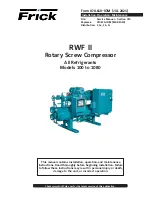
070.610-IOM (JUL 21)
Page 13
RWF II Rotary Screw Compressor Units
Installation
Figure 15: Flash economizer system
HIGH
PRESSURE
LIQUID
INTERMEDIATE PRESSURE
GAS TO COMPRESSOR
SUCTION
STR
VCK
CONTROLLED
PRESSURE
SATURATED LIQUID
TO EVAPORATOR
ECONOMIZER
VESSEL
BPR
ECON3
HV-2
Figure 16: Multiple compressor economizer system
INTERMEDIATE PRESSURE
GAS TO COMPRESSOR
SUCTION
STR
VCK
BPR
CONTROLLED PRESSURE
SATURATED LIQUID TO EVAPORATOR
ECONOMIZER
VESSEL
ECON4
HV-2
Economizer load balancing
The most energy efficient manner to operate an econo
-
mizer system, when using multiple compressors on a com
-
mon economizer vessel, is to take as much of the flash gas
as possible to the compressors that are fully loaded. This
can be done in at least two ways.
1.
Use the economizer output from the microprocessor
to turn off a solenoid, or to actuate the electric shutoff
option on a
back-pressure regulator, based on percent of
slide valve travel. This will direct all the
flash vapor to the
other loaded compressors.
2.
A dual-setpoint, back-pressure regulator valve can
be used in each of the individual economizer vapor lines.
When a compressor is running near full load, the BPR
valve will operate on the desired setpoint, or basically
wide open, to minimize pressure drop in the line. When
one compressor unloads below the slide valve position
where the economizer output on the microprocessor turns
on, the dual-setpoint feature of the regulator can be actu
-
ated by this output to control the pressure, on the vessel
side of the regulator, to be a few psi higher. Consequently,
the
flash gas will be sent to the loaded compressors first,
until they can’t handle all the vapor and the pressure in
the vessel starts to rise. Then, some of the vapor will go
to the unloaded compressor to help maintain the vessel
at the desired pressure. An example of a back-pressure
regulator with electric shutoff and the
dual-setpoint fea-
ture is an R/S A4ADS.
Economizer Vi control
Based on suction and discharge pressures, the control
panel calculates the proper volume ratio (Vi) for the com
-
pressor. However, additional refrigerant vapor entering
through the economizer port affects this calculation. If the
addition of economizer gas is not taken into account the
compressor will over-compress. This uses more energy
than necessary.
Quantum control panels are capable of adjusting the Vi to
compensate for economized compressors. If the econo-
mizer pressure is fixed, a regulating valve may be used. In
this case, the economizer operating pressure can simply
be entered into the control panel.
If the economizer pressure fluctuates, then the econo
-
mizer pressure can be relayed to the control panel via a
pressure transducer to an analog input. This is the purpose
of the powermizer option. If the powermizer option is
selected, Frick provides a factory mounted and wired
pressure transducer on the economizer inlet.
Economizing with VSDs
Economizing on a variable speed machine can present
challenges. At low load conditions, the mass flow through
the economizer line is reduced. This tends to cause the
economizer check valve to chatter. Chattering will lead to
premature failure of the check valve.
This can be avoided through the use of a smaller check
valve or by limiting the minimum speed of the compres
-
sor. The disadvantage of using a smaller check valve is
increased pressure drop during full load conditions. If ex
-
tended periods of low compressor loading are anticipated,
it is recommended to use an automated (non-modulating)
full port ball valve in lieu of a check valve. This valve shall
be equivalent in size to the economizer line size. The ball
valve shall be opened when the compressor starts, and
closed when the compressor stops. The ball valve must
close automatically upon power failure.
Electrical
NOTICE
Before proceeding with electrical installation, read
the instructions in the section “Proper Installation of
Elec tronic Equip ment in an Industrial Environment”.
RWF II units are supplied with a Quantum™ HD control
system. Care must be taken that the controls are not
exposed to physical damage during handling, storage, and
installa tion. The single-box control door must be kept
tightly closed to prevent moisture and foreign mat ter from
entry.
NOTICE
All customer connections are made in the single-
box control mounted on the oil separator. This is
the ONLY electrical enclosure and it should be kept
tightly closed whenever work is not being done in it.














































